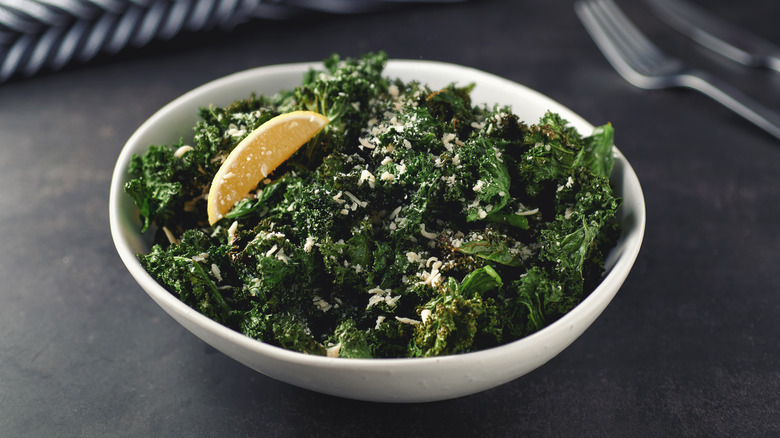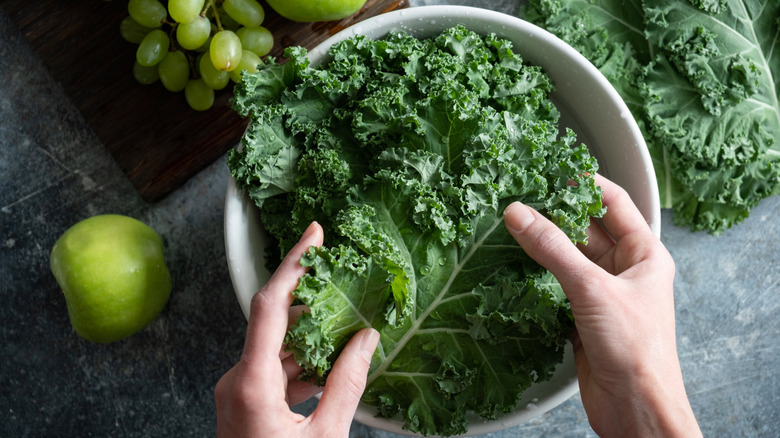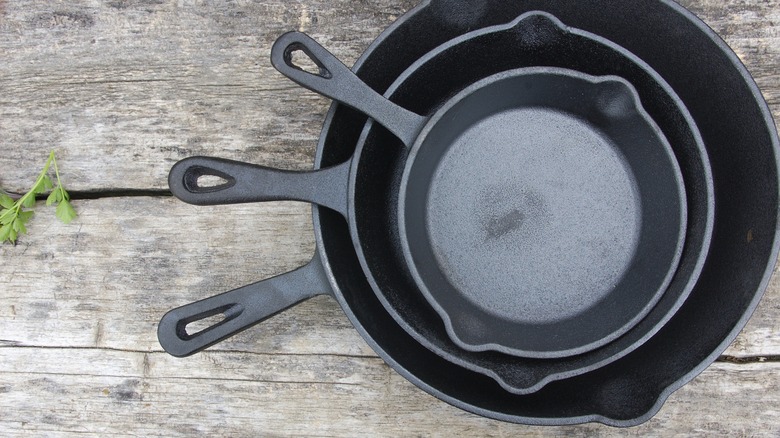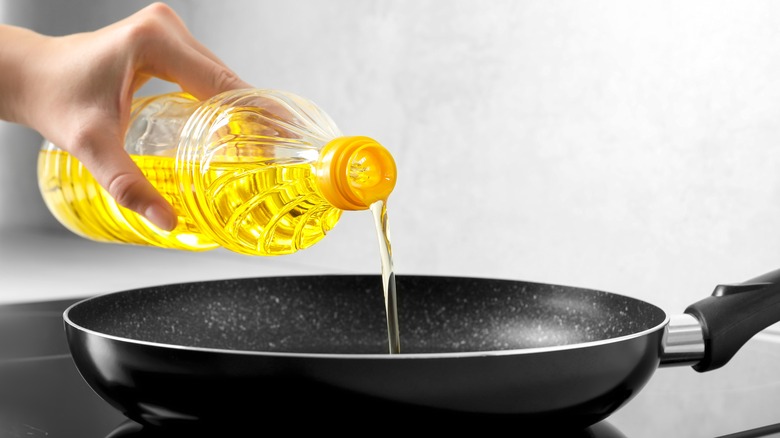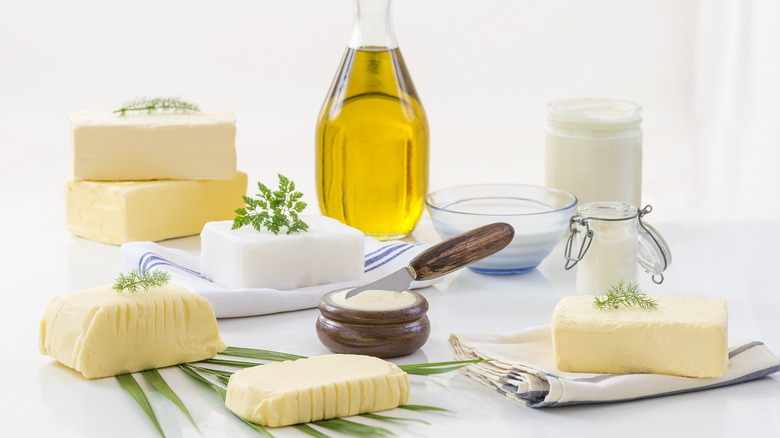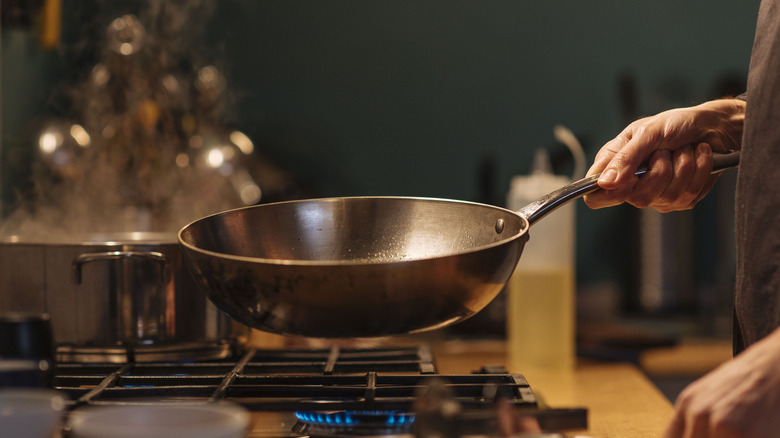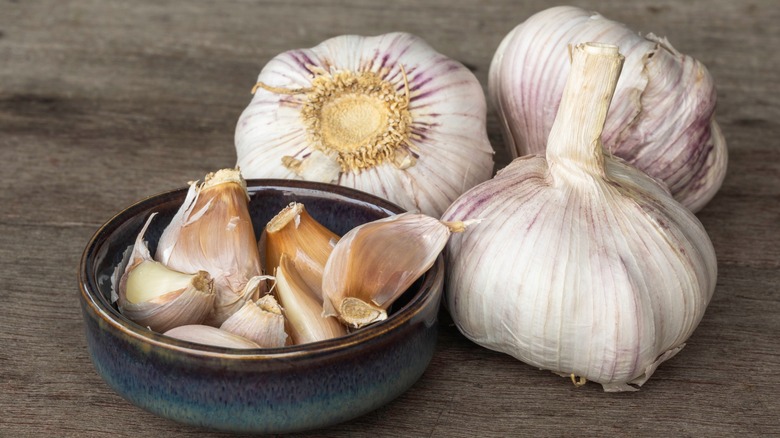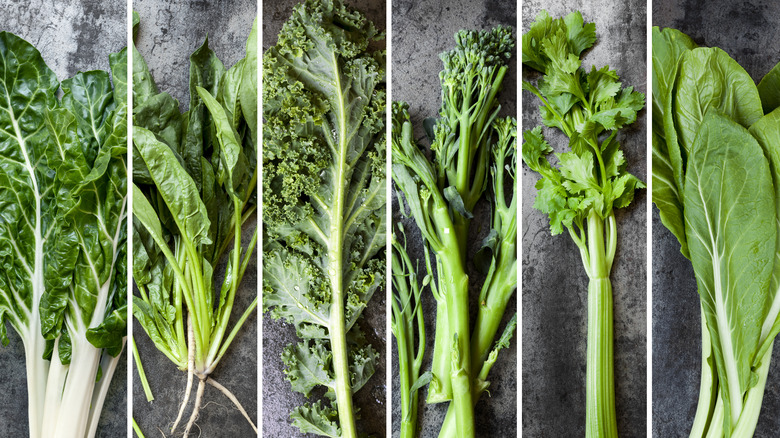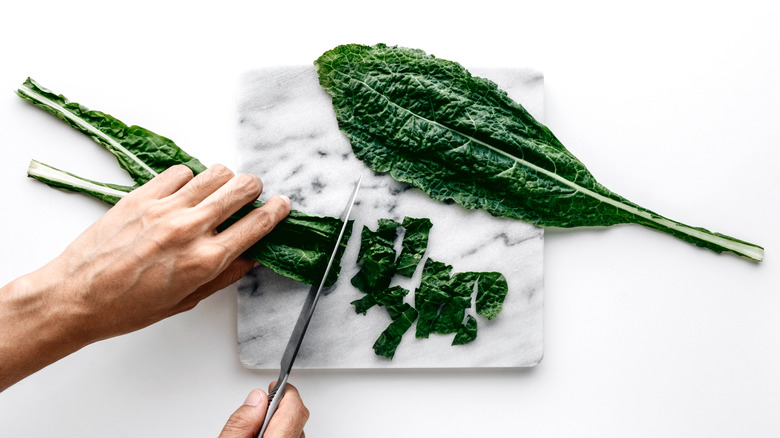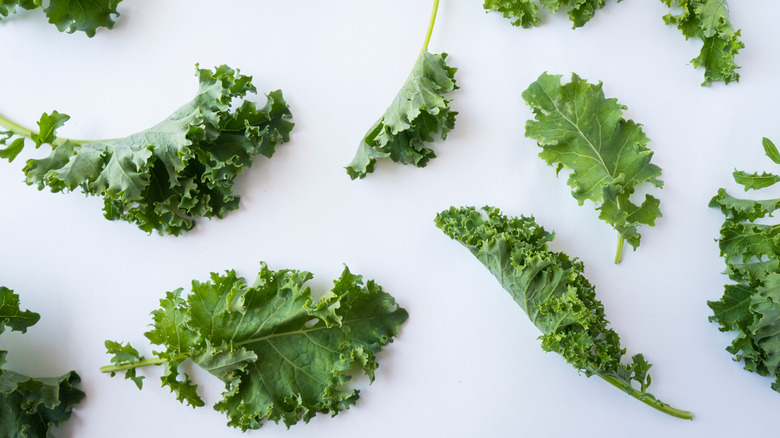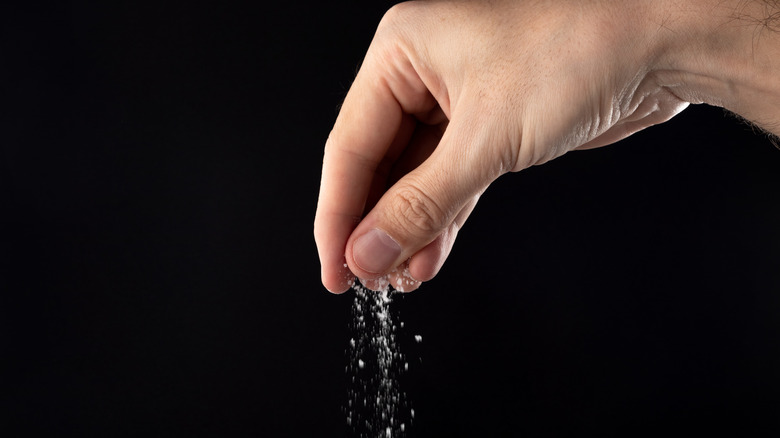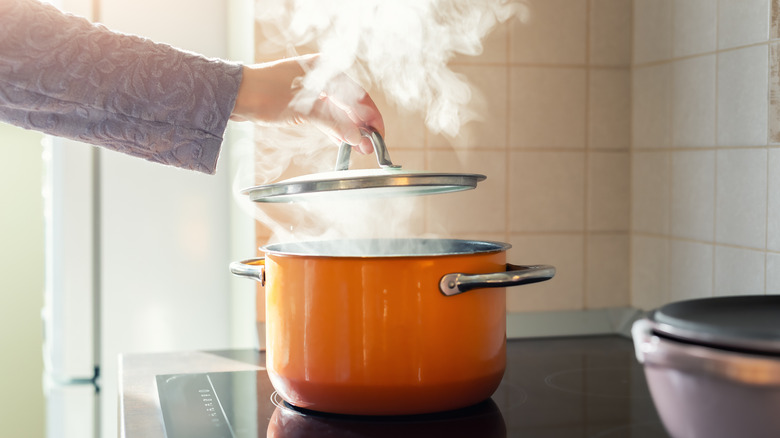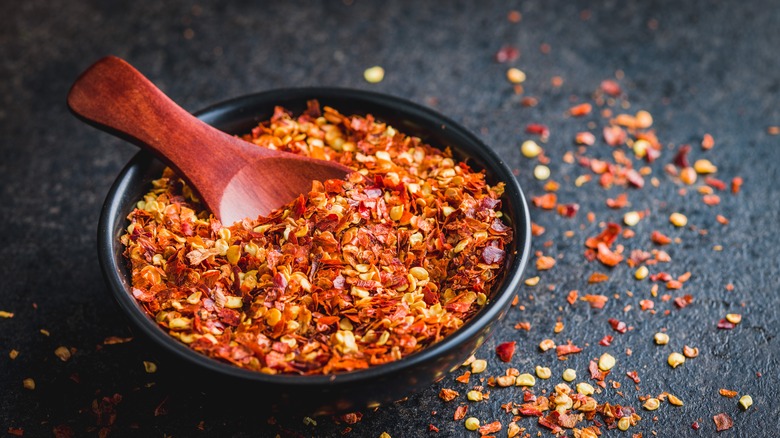Mistakes Everyone Makes When Sautéing Greens
Transforming tough, fibrous greens into an appetizing part of your meal is not as simple as tossing them in a pan and hoping for the best. They aren't like potatoes that will easily steal the show once you add some butter and salt. Nor are they like lettuce, which only needs to be washed and drizzled with a flavorful dressing to be enticing. Greens are full of healthy fiber, low in calories, and provide a hefty dose of vitamins. Their vitamin K content helps create and maintain bone density, while the vitamin B they provide promotes a healthy heart. They are also packed with antioxidants, one of the best lines of defense against cancer. All in all, it's clear that we should be eating more greens, but how you make them taste delicious is a little less obvious.
One of the best options is to sauté them. Unlike boiling or steaming, this method injects them with flavor and gives them a buttery texture that can still have crispy edges. Because many types of leafy greens are tough and fibrous, tossing them in a skillet with olive oil for a few minutes isn't going to produce appetizing results. There are several pitfalls people make with sautéing greens that leave them chewy, flavorless, and downright inedible. Keep reading to discover the mistakes we all make with sautéing these vitamin-packed powerhouses, and how you can make them tender and flavorful every time.
Not washing the greens thoroughly enough
The first potential pitfall comes with washing the greens. This is an easy step to skip because, quite frankly, it's a pain. The leaves are too delicate to scrub the way you would potatoes or carrots, and some varieties, such as mustard greens and certain types of kale, have frilly edges that are difficult to clean fully, even when you run a powerful stream of water directly onto them. And yet, washing greens is non-negotiable. Vegetables are often the cause of foodborne illnesses due to contamination by bacteria such as E. coli, norovirus, and Listeria. Beyond these dangerous germs are less harmful but more immediately obvious contaminants like dirt and grit that might hurt your teeth when you bite down or leave an unpleasant taste in your mouth.
To avoid these risks, washing is a necessity. To do so thoroughly, soak them in a water bath instead of holding them under a running tap. This gives the dirt time to dislodge from all the nooks and crannies of the leaves and sink to the bottom of the bowl. Give them a final rinse and spin them in a salad spinner to remove excess moisture.
Using the wrong size pan
The size of the pan you use might not seem like a big deal. Sure, it might take the food longer to cook if it's crowded, but doesn't that just mean you have to cook it longer? The trouble with an overcrowded pan is that, instead of sautéing, the food steams. All the greens need to be touching the pan to brown and develop a lightly roasted flavor. Additionally, the temperature of the food lowers when the pan is crowded, causing moisture to build instead of evaporate. Rather than becoming caramelized, the greens become soggy and flavorless as if you just boiled them instead.
As a general rule, the greens should fit comfortably in the pan in a single layer, with gaps visible. Keep in mind that leafy greens cook down to a fraction of their original size, so it's okay if the pan looks a little crowded when you add the fresh leaves. When in doubt, opt for more rather than less space. If you end up with huge gaps between your sautéing greens, you can always move your pan partially off the burner and only use half of it for cooking.
Not using enough oil
Oil is full of calories. There's no getting around it. Whether you're using butter, avocado oil, or lard, adding it to your greens will significantly increase the number of calories in the dish. A single tablespoon of olive oil contains about 120 calories, more than a slice of bacon, and just barely less than 10 Doritos. But oil is a necessary part of sautéing if you want that trademark browning and lightly caramelized flavor. It also plays a crucial role in cooking the food evenly and preventing it from sticking to the pan.
Oil creates a medium where the heat from the pan travels to the greens, slowing the cooking process. If parts of the greens are touching the pan without oil to buffer them, they will cook more quickly and burn before the rest of the greens are fully cooked. If your greens aren't burning despite being in an unevenly oiled pan, it is likely because you've lowered the heat to avoid sticking and overcooking. As a result, the greens will be steamed in their own moisture rather than sautéed, leaving them limp and soggy. Adding more oil is always better than adding less when you're using this cooking method. If your pan becomes dry during the course of sautéing, do not be afraid to add another teaspoon or two of oil. The results will speak for themselves.
Using the wrong type of oil
Greens don't have any internal fats the way bacon, halloumi, and many other commonly sautéed ingredients do, so you have to add all the oil from an external source. There are two main factors to consider when choosing a cooking oil –- the type of fat it contains and its smoking point. Although all oils contain about 9 calories per gram, they vary greatly in health benefits and risks. Fats that are solid at room temperature (such as coconut oil and most animal fats) contain saturated fats that can raise cholesterol levels and increase the risks of heart disease. On the other hand, oils high in polyunsaturated and monounsaturated fats have been shown to lower unhealthy cholesterol, thereby decreasing the risks of heart disease.
The smoking point is just as critical. When oils reach their burning point, they release free radicals, which are chemicals that lead to oxidative stress and are linked to an array of risks such as cardiovascular disease, certain cancers, and inflammatory diseases. On a less calamitous note, burnt oil just tastes bad, and the last thing you want is sautéed greens that taste bitter and rancid. For an oil with a high smoke point that is also high in healthy fats, canola oil, avocado oil, and safflower oil stand out. They also have neutral flavors that won't interfere with the ingredients you're sautéing.
Not preheating the oil
Once you've established the type of oil you're going to use and added a generous portion to the pan, you are still not in the clear. The final oil-related hurdle is preheating. A cool or lukewarm pan will slowly draw out moisture from the food, but it will not be hot enough to burn off the moisture. Instead, your greens will be left to bubble away in their own juices, and by the time the liquid has burned off and the pan is hot, the oil will be displaced, and your greens will burn and stick. The other issue with adding the leaves too early is that they will absorb the oil. When the oil is properly heated, it creates a seal on the outside of the food. When it's cool, however, the food has time to absorb it. As a result, you'll end up with greasy greens rather than caramelized ones.
The question then arises of how you know when the oil is hot enough. Unlike the preheating function on an oven, most stoves do not alert you when the pan has reached the desired temperature, and a surface thermometer isn't a common kitchen tool. To tell if your pan is hot enough, wait to add your oil until a few drops of water skitter, bubble, and evaporate across the surface in a couple of seconds. Then, add the oil and wait 30 seconds before adding any other ingredients.
Adding garlic too early
Many recipes for sautéed greens include garlic. It's an easy way to inject flavor into the dish without overshadowing the main ingredient, and it's a broadly appealing addition that won't ruffle many feathers. Unfortunately, garlic burns very quickly and is just as good at suffusing food with its bitter, charred flavor as it is its deliciously spicy, perfectly cooked flavor. Sautéing requires high heat, which makes it a particularly tricky form of cooking for delicate ingredients like garlic. One minute, you have a fragrant, sizzling patch of minced garlic, the next, a pungent clump of bitterness.
Believe it or not, garlic only takes 30 to 60 seconds to cook. Anything beyond this will make it burn. If your recipe calls for sautéing onions and garlic at the same time until the onion is translucent, you will most likely end up with perfectly cooked onions and conspicuously overcooked garlic. To avoid this, add the onion by itself and wait until it's almost fully cooked. Then, about a minute before you're ready to remove the pan from the heat, add the garlic.
Using a one-size-fits-all approach
The phrase "leafy greens" encompasses a wide range of veggies that are not created equal. While kale and collards are tough and fibrous, spinach is so fragile you might only have to cook it for a matter of seconds. As a consequence, you'll need to choose the varieties carefully or alter your preparation methods to avoid having some greens end up nearly raw, and others slimy and mushy from overcooking.
The easiest option is to cook a single type of green. If you opt for this route, make sure you're using a recipe tailored to that specific ingredient (using a sautéed spinach recipe for kale will yield nearly raw kale). Another option is to use similar types of greens. Collards and kale have a comparably tough, fibrous texture, for example, while chard and beet greens have a similarly meaty but delicate structure. If you want to serve kale and chard together, however, there are a few ways to prep the kale so that it will cook at the same rate as its more tender companion. The first option is to steam it. This cooks the kale before you even begin to sauté it, ensuring that there is no toughness whatsoever. Another less drastic option is to massage it. This process, which involves rubbing the leaves together for several minutes to break down their fibrous texture, ensures that it will be tender when you add it to the sauté pan but not loaded with unnecessary moisture.
Not cutting the stems properly
Nothing spoils a delicious batch of sautéed greens as much as a rogue stem. Thick and chewy, they are even more fibrous than raw kale and have an intensely bitter flavor. Removing them can be tricky, especially when there are frilly leaves in the way, but doing so can make or break the final product. There are plenty of hacks you'll find for this step, from stripping the leaves with your bare hands to threading them through the top of a pair of tongs, but flattening each leaf and using a well-sharpened knife to slice along the sides of the stem is just as quick. It also ensures that you don't leave behind any usable parts of the leaf. Any stems a quarter of an inch thick or less are edible.
Keep in mind that stems are another area where greens vary. Although they should be removed when making kale or collards, beet green stems and chard stems are tender enough to sauté and add an earthy sweetness that will greatly enhance the dish. Just make sure to add them to the aromatics first before adding the leaves, since they will still take a little longer to cook. Even if you're cooking kale, do not discard the stems. You can easily turn them into pickles or even deep fry them for delicious results.
Not using enough greens
No matter how many times you cook leafy greens, you will probably never cease to be amazed by how much they cook down. Depending on the context, watching an enormous bag of spinach wither away into a measly spoonful or two will either bring you to laughter or rage. But either way, we can all agree that a little more predictability would be helpful.
Different types of greens cook down to varying degrees. In general, a pound (approximately two bunches) of hearty greens such as kale or chard will cook down to four or five cups, or about 40% of their original volume. When you see all the raw, de-stemmed leaves overflowing the mixing bowl, you might think you've made a mistake and doubled the recipe, but rest assured that those fibrous greens will shrink to almost nothing. Spinach undergoes an even more dramatic transformation. For a single cup of sautéed leaves, you'll need a whopping 10-12 cups of raw, chopped leaves. So, the next time you're at the grocery store, don't skimp on fresh greens. You'll end up with a lot less than you think.
Adding salt too early
Many chefs and cooking experts emphasize the need to season a dish throughout the cooking process to ensure that every layer is full of flavor. But when it comes to leafy greens, the rules are different, and salting too early can lead to unwanted results. Salt draws out moisture, and if you add it to greens before they begin to wilt, it will create a moist environment outside the leaves that will quickly turn to steam. Consequently, the greens will be cooked by the steam rather than the dry heat of the oiled pan, leaving them limp and soggy.
Not only will waiting to add the salt prevent accidental steaming, but it will also ensure that you don't end up with too much salt. Since greens cook down to a fraction of their original size, it's easy to overestimate how much seasoning you'll need when you're looking at the fresh leaves, only to end up with inedibly salty results when they've cooked.
Not accounting for bitterness
Despite how lauded they are for their vitamins and easy integration into a wide range of dishes, greens often have a bitter aftertaste that can be downright unpalatable when served on their own. This is rarely noticeable in soups and stir-fries because there are plenty of other ingredients to outweigh the bitterness, but when you're serving a dish made almost entirely of robust, leafy greens, you might notice an unexpected and unwelcome pungency.
To combat this, you have a few options, most of which you probably already have in your kitchen. Sugar is perhaps the easiest and most readily available counterweight to the unwanted flavor. The trick is to add enough sweetness to balance the bitterness without giving the greens a recognizably sweet flavor. Start with a pinch, then taste and add more as needed. You can also add the sweetness as a separate element, such as with dried fruit. Sourness is also a counterweight. Lemon juice and vinegar are the obvious choices, lending a brightness that takes the edge off the bitterness. You can also combine the sweet and sour elements in one ingredient, such as balsamic or umeboshi vinegar. If you're unsure about which greens need the most balancing, mustard, collards, and kale are at the far end of the bitter spectrum, while spinach is mild enough that you might not need to add anything to combat bitterness at all.
Covering the pan with a lid
The downfall of many a sautéed veggie recipe is accidental steaming. There are a frustrating number of ways this can happen. Overcrowding, adding salt too early, and adding the ingredients to a cold pan are all direct routes to this outcome, but one of the surest and most avoidable ways to cook with moisture is covering your pan. You might add the lid to your pan if you're cooking tough greens that just aren't getting tender, or maybe you do it because it traps the heat inside and makes things cook faster. But doing this will only leave you with water-logged greens devoid of any caramelized flavor.
Covering your pan is fine if you're simmering, boiling, or steaming, but it's taboo if you're sautéing, especially with ingredients that are already full of moisture. Raw kale is about 90% water, and spinach is more than 91% water. You'll be combating moisture the whole way, so doing anything that traps it inside the pan is exactly the opposite of what you want to be doing.
Ignoring other flavors
Making sautéed greens doesn't mean that the only ingredients you can use are green and leafy. There are plenty of additional flavors you can add to enhance but not overwhelm the star of the show. Garlic is the go-to option found in many recipes. It adds a pleasantly sharp, pungent flavor and aroma that immediately upgrades the greens from demure to attention-grabbing. Another easy upgrade in addition to the garlic is red pepper flakes. With just a few shakes, you'll have a kick of heat and savoriness on top of the familiar garlic flavor. Lemon juice and vinegar are also popular options and serve to balance some of the bitterness inherent in sturdier types of greens.
For more adventurous flavors, opt for the sweetness of shallots, the smokiness of smoked paprika, or the salty umami notes of Parmesan cheese. Toasted pine nuts and sunflower seeds add a buttery, crunchy element, while sun-dried tomatoes add a hint of Mediterranean warmth and sweetness.
